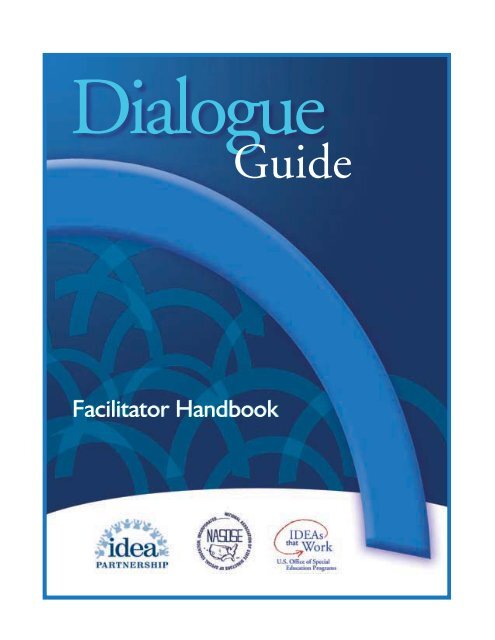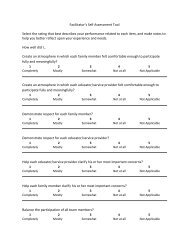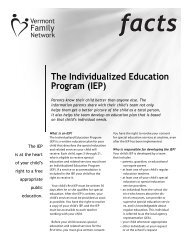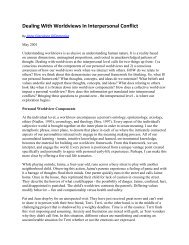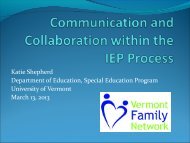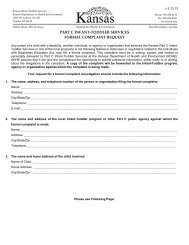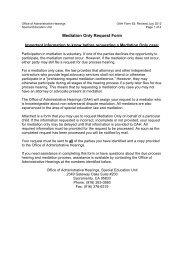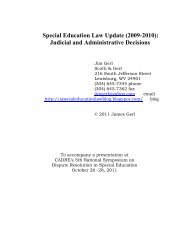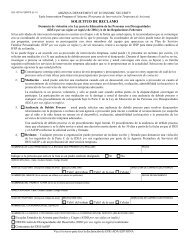the Facilitator Handbook - IDEA - U.S. Department of Education
the Facilitator Handbook - IDEA - U.S. Department of Education
the Facilitator Handbook - IDEA - U.S. Department of Education
- No tags were found...
Create successful ePaper yourself
Turn your PDF publications into a flip-book with our unique Google optimized e-Paper software.
Guide<strong>Facilitator</strong> <strong>Handbook</strong>
DIALOGUE GUIDEFACILITATOR HANDBOOKMay 2005National Association <strong>of</strong> State Directors<strong>of</strong> Special <strong>Education</strong>, Incorporated1800 Diagonal RoadSuite 320Alexandria, Virginia 22314Phone: 703.519.3800Fax: 703.519.3808TDD: 703.519.7008www.nasdse.orghttp://ideapartnership.orgPublication <strong>of</strong> this document is made possible through Cooperative Agreement#326A010001 between <strong>the</strong> National Association <strong>of</strong> State Directors <strong>of</strong> Special<strong>Education</strong> (NASDSE) and <strong>the</strong> Offi ce <strong>of</strong> Special <strong>Education</strong> Programs <strong>of</strong> <strong>the</strong> U.S.<strong>Department</strong> <strong>of</strong> <strong>Education</strong>. The contents <strong>of</strong> this document do not necessarilyrefl ect <strong>the</strong> views or policies <strong>of</strong> <strong>the</strong> <strong>Department</strong> <strong>of</strong> <strong>Education</strong>, nor does mention<strong>of</strong> trade names, commercial products, or organizations imply endorsement by<strong>the</strong> U.S. Government or by NASDSE.ii ...........................................................................................................................<strong>IDEA</strong> Partnership
DIALOGUE GUIDEFACILITATOR HANDBOOKTable<strong>of</strong>ContentsForeword ............................................................... 1Introduction ..........................................................3Understanding Dialogue Guides ...........................7Organizing a Dialogue Guide Activity ...................11Convening a Dialogue Guide Activity ...................17Taking <strong>the</strong> Dialogue Guides a Step Fur<strong>the</strong>r ...........23Acknowledgments .................................................25<strong>IDEA</strong> Partnership ......................................................................................................................... iii
DIALOGUE GUIDEFACILITATOR HANDBOOKiv ...........................................................................................................................<strong>IDEA</strong> Partnership
DIALOGUE GUIDEFACILITATOR HANDBOOKForewordWelcome to <strong>the</strong> <strong>IDEA</strong> Partnership!* We are devoted to stimulating new ways forstakeholders—administrators, service providers, family members, policymakers,and o<strong>the</strong>r interested individuals—to work toge<strong>the</strong>r on issues related to <strong>IDEA</strong> 2004that are shared across states and districts; across roles and relationships. To accomplishthis goal, <strong>the</strong> <strong>IDEA</strong> Partnership provides opportunities for stakeholders tomove beyond information and build shared meaning; to go beyond disseminationto joint understanding and action.Your opportunity tobecome involvedWe invite you to assist us in one <strong>of</strong> our major initiatives—providing opportunitiesfor meaningful dialogue associated with <strong>IDEA</strong> 2004. To support this venture, <strong>the</strong><strong>IDEA</strong> Partnership has developed a set <strong>of</strong> innovative tools called Dialogue Guides.Each Dialogue Guide focuses on an issue relevant to understanding <strong>IDEA</strong> 2004and directs stakeholders to useful materials that have been produced through federalresearch and technical assistance projects. Within <strong>the</strong> Dialogue Guides are suggestionsfor:• creating dialogue related to <strong>the</strong> issue;• building shared meaning; and• generating solutions to issues <strong>of</strong> mutual importance.A capable facilitator is essential to <strong>the</strong> success <strong>of</strong> Dialogue Guide activities.Individuals who serve in leadership roles—principals, parent leaders, state chapterpresidents <strong>of</strong> pr<strong>of</strong>essional organizations, local district special education directors,faith-based leaders, etc.—are typically considered to be prime facilitator candi-The <strong>IDEA</strong> Partnership is housed at <strong>the</strong> National Association <strong>of</strong> State Directors <strong>of</strong> Special <strong>Education</strong> (NASDSE) and is* funded by <strong>the</strong> U.S. <strong>Department</strong> <strong>of</strong> <strong>Education</strong>, Office <strong>of</strong> Special <strong>Education</strong> Programs (OSEP).<strong>IDEA</strong> Partnership ...........................................................................................................................1
DIALOGUE GUIDEFACILITATOR HANDBOOKdates. However, more important than job title orposition are <strong>the</strong> qualities and skills that a facilitatorbrings to <strong>the</strong> task.<strong>Facilitator</strong>s organize and convene Dialogue Guideactivities and provide follow-up assistance to keep<strong>the</strong> work <strong>of</strong> <strong>the</strong> dialogue group going and growing.Dialogue Guide facilitators are expected tohelp groups—composed <strong>of</strong> individuals with similarroles or individuals who represent a variety <strong>of</strong> stakeholderroles—share <strong>the</strong>ir ideas and opinions and togenerate ideas that build upon initial events. To thisend, facilitators should:• be comfortable serving in a role that requires<strong>the</strong>m to remain neutral during discussions;• be skilled in reaching out to individuals whorepresent diverse points <strong>of</strong> view and engaging<strong>the</strong>m with o<strong>the</strong>r participants in meaningfulways;• be someone who is trusted by stakeholders;• have credibility with participating individuals,which assumes an understanding <strong>of</strong> <strong>the</strong>jargon, context and politics <strong>of</strong> those who areparticipating; and• be able to translate ideas and perspectivesacross roles.Being a facilitator <strong>of</strong> a Dialogue Guide activity involvesa commitment in terms <strong>of</strong> time and energy.This Dialogue Guide <strong>Facilitator</strong> <strong>Handbook</strong> was writtento assist facilitators in carrying out DialogueGuide activities.Your call to action—Helpidentify and supportDialogue Guide facilitatorsIf you are a facilitator…We invite you to read through <strong>the</strong> Dialogue Guide<strong>Facilitator</strong> <strong>Handbook</strong> to gain a solid understanding<strong>of</strong> Dialogue Guide activities and <strong>the</strong> type <strong>of</strong> facili-tation that is necessary for success. We encourageyou to reflect on your strengths in carrying out <strong>the</strong>facilitator’s role and associated responsibilities. Askyourself, “Am I comfortable assuming <strong>the</strong> role <strong>of</strong>facilitator—or is someone else a better choice? DoI have <strong>the</strong> time and energy required to carry out all<strong>of</strong> <strong>the</strong> tasks?”If you are interested in hosting aDialogue Guide activity, but will assignor recommend a facilitator…We invite you to read through <strong>the</strong> Dialogue Guide<strong>Facilitator</strong> <strong>Handbook</strong> to gain a better understanding<strong>of</strong> <strong>the</strong> facilitator’s roles and responsibilities. Askyourself, “Does <strong>the</strong> potential facilitator have <strong>the</strong>skills and characteristics necessary to ensure success?Does <strong>the</strong> individual have <strong>the</strong> time and supportneeded for <strong>the</strong> activity?” Share <strong>the</strong> handbook witho<strong>the</strong>rs who may be nominating candidates. Make<strong>the</strong> handbook available to potential facilitators.Encourage <strong>the</strong>m to read and reflect on <strong>the</strong>ir abilityand interest in serving in <strong>the</strong> role before making afinal decision.Your invitation tostay involvedThis is only a starting point. As <strong>the</strong> <strong>IDEA</strong>Partnership convenes Dialogue Guide activitiesthroughout <strong>the</strong> country, participants’ stories andinsights will be used to inform and shape futurepractices. Participants will share and exchange feedbackvia <strong>the</strong> <strong>IDEA</strong> Partnership websites athttp://ideapartnership.orgorhttp://ideainfo.orgWe invite you to stay connected to <strong>the</strong> work <strong>of</strong>Dialogue Guide participants by joining our onlinediscussions.2............................................................................................................................<strong>IDEA</strong> Partnership
DIALOGUE GUIDEFACILITATOR HANDBOOKIntroductionWelcome, Dialogue Guide <strong>Facilitator</strong>s!All children deserve a quality education, one in which <strong>the</strong>y can learn and achieveto high standards alongside <strong>the</strong>ir peers. For <strong>the</strong> more than six million children andyouth with disabilities in this country, <strong>the</strong> right to a free and appropriate public educationis supported by <strong>the</strong> Individuals with Disabilities <strong>Education</strong> ImprovementAct (<strong>IDEA</strong> 2004). However, as <strong>the</strong> following scenarios suggest, implementing <strong>IDEA</strong>2004 does not come without challenges—many <strong>of</strong> which require <strong>the</strong> collaboration<strong>of</strong> diverse groups <strong>of</strong> stakeholders. For example:A local director <strong>of</strong> special education has been charged with leading <strong>the</strong> districtwideeffort to develop a system for intervening early on academic difficulties. One <strong>of</strong> <strong>the</strong>main goals <strong>of</strong> this system is to help prevent <strong>the</strong> overidentification <strong>of</strong> students fromculturally and ethnically diverse backgrounds. Acknowledging <strong>the</strong> importance <strong>of</strong>this task—not to mention <strong>the</strong> need for all <strong>of</strong> <strong>the</strong> many stakeholders to be involvedin <strong>the</strong> planning and implementation—<strong>the</strong> director decides to convene a series <strong>of</strong>dialogue groups that focus on exploring <strong>the</strong> issues related to overidentification.…While volunteering at <strong>the</strong>ir children’s school, a group <strong>of</strong> parents started talking informallywith several teachers about how student progress is reported. Both teachersand parents shared things that <strong>the</strong>y thought worked well, as well as things <strong>the</strong>ywould like to see done differently. At <strong>the</strong> end <strong>of</strong> <strong>the</strong> discussion, one <strong>of</strong> <strong>the</strong> discussantsasked, “Wouldn’t it be great to talk to o<strong>the</strong>r parents and teachers about <strong>the</strong>ir ideasand thoughts?” The group agreed and set about inviting o<strong>the</strong>r teachers and parentsto a brown bag lunch to share <strong>the</strong>ir insights and ideas.…Keeping highly qualified teachers has always been a major concern for <strong>the</strong> district.But this year, faced with mounting shortages <strong>of</strong> special education teachers, prin-<strong>IDEA</strong> Partnership ...........................................................................................................................3
DIALOGUE GUIDEFACILITATOR HANDBOOK6............................................................................................................................<strong>IDEA</strong> Partnership
DIALOGUE GUIDEFACILITATOR HANDBOOKUnderstanding DialogueGuidesAn Overview for <strong>Facilitator</strong>s…Offering mental health services…Providing alternate assessments…Aligning <strong>the</strong> No Child Left Behind Act with <strong>IDEA</strong> 2004…Ensuring access to early intervention…Supporting <strong>the</strong> transition to adult lifeThese are just a sampling <strong>of</strong> <strong>the</strong> many issues facing stakeholders as <strong>the</strong>y work to ensurehigh-quality education for children and youth with disabilities. What defines<strong>the</strong> issues is <strong>the</strong>ir relevance and importance to stakeholders and <strong>the</strong> need for unifiedaction across stakeholder groups to find solutions.Needed: A means to connect stakeholders whocare about <strong>the</strong> issues and who seek unifiedsolutions to <strong>the</strong>mThe <strong>IDEA</strong> Partnership has developed Dialogue Guides for this purpose. DialogueGuides are tools that identify relevant issues pertaining to <strong>the</strong> implementation <strong>of</strong><strong>IDEA</strong> 2004 and direct stakeholders to materials for improving results for childrenwith disabilities. Accessibility and usability are enhanced through <strong>the</strong> DialogueGuide format, which engages stakeholders in:<strong>IDEA</strong> Partnership ...........................................................................................................................7
DIALOGUE GUIDEFACILITATOR HANDBOOK• exploring toge<strong>the</strong>r <strong>the</strong> practical value <strong>of</strong> informationand knowledge;• developing a shared process for managing andreflecting on information; and• becoming better able to act jointly uponshared knowledge to improve practice.To ensure relevance, all Dialogue Guides are developedby stakeholders who are actively engaged in<strong>the</strong>ir work, who have identified <strong>the</strong> issues, reviewed<strong>the</strong> available materials (most <strong>of</strong> which can be accessedvia web downloads or are available in <strong>the</strong>particular Dialogue Guide) for relevancy and writtenquestions to stimulate dialogue.Several Dialogue Guides are available for each topic.For example, <strong>the</strong>re are:• Cross-stakeholder guides. The nature <strong>of</strong>some issues necessitates bringing toge<strong>the</strong>rdiverse viewpoints and talents. Cross-stakeholderDialogue Guides facilitate <strong>the</strong>se kinds<strong>of</strong> interaction.• Role-alike guides. Certain documents mightrequire a more in-depth look at a documentthrough <strong>the</strong> lens <strong>of</strong> a particular audience (e.g.,youth, families and advocates; administrators;policymakers; teachers; or related service providers).Role-alike Dialogue Guides facilitate<strong>the</strong>se kinds <strong>of</strong> interactions.The Dialogue Guides are located on <strong>the</strong> <strong>IDEA</strong>Partnership website and are customized to each user.To retrieve your customized Dialogue Guide, go tohttp://ideapartnership.org and click on DialogueGuides. You will be prompted to:1. Choose a topic.2. Describe <strong>the</strong> individuals in <strong>the</strong> DialogueGuide group.Once you answer <strong>the</strong> prompts, you will be ableto review online and/or download <strong>the</strong> DialogueGuide, which includes:• a facilitator’s guide;• documents for review; and• dialogue questions.Introductory Dialogue GuideElementsDialogue Guides are intended topromote dialogue centeredon an issue <strong>of</strong> high interestto <strong>the</strong> education community.The following elementswill guide <strong>the</strong> groupthrough <strong>the</strong> dialogue process:• Full text document—An unedited documentproduced through federal researchand/or technical assistance projects that isevidence-based and generally acknowledgedas valuable within <strong>the</strong> education communitymay be included (or a link is provided fordownloading). Note: In some cases, a summarysheet may be presented instead <strong>of</strong> <strong>the</strong>full document.• Summary sheet—In some cases (e.g.,lengthy documents), a brief syn<strong>the</strong>sis <strong>of</strong> <strong>the</strong>information covered in <strong>the</strong> complete document,written in a straightforward, easy-toreadstyle may be included.• Dialogue questions—Questions that reflect what stakeholders believe is importantfor people in <strong>the</strong> fi eld to discuss are presented.Stakeholder-identifi ed data from nationalstudies that are relevant to <strong>the</strong> topic and thathave implications for practice and data pointsand questions that engage participants in exploring<strong>the</strong> information also may be included.After selecting a particular issue for a DialogueGuide activity, facilitators might consider familiarizing<strong>the</strong>mselves with all <strong>of</strong> <strong>the</strong> Dialogue Guidesfor that topical area. This is recommended for tworeasons: to enhance one’s understanding <strong>of</strong> <strong>the</strong> issueand to provide ideas in <strong>the</strong> event <strong>the</strong> initialgroup wishes to expand its efforts. For example, arole-alike group decides to invite o<strong>the</strong>r stakeholdersinto <strong>the</strong> dialogue. Knowledge <strong>of</strong> how <strong>the</strong> Dialogue8............................................................................................................................<strong>IDEA</strong> Partnership
DIALOGUE GUIDEFACILITATOR HANDBOOKGuide addresses <strong>the</strong> issue for cross-stakeholdersmight prove useful in planning this next event, as is<strong>the</strong> case in <strong>the</strong> following example:Discipline was high on <strong>the</strong> list <strong>of</strong> potential topics.But as <strong>the</strong> facilitator thought about <strong>the</strong> topic, herealized that in order to make <strong>the</strong> topic appealto a variety <strong>of</strong> stakeholders (e.g., family members,mental health agencies, community servicesgroups and faith-based organizations) it wouldhave to be expanded. His ultimate goal was tobring toge<strong>the</strong>r representatives from <strong>the</strong>se differentgroups to create new bonds. As <strong>the</strong> facilitatortalked with several colleagues, he determinedthat <strong>the</strong> topic was better framed as “supportingpositive mental health in our children.”The <strong>IDEA</strong> Partnership website (http://ideapartnership.org)also features comments and suggestionsfrom facilitators who have used <strong>the</strong> DialogueGuides and from individuals who have participatedin Dialogue Guide activities. Take some time tolearn from your colleagues’ experiences using <strong>the</strong>tools.Part <strong>of</strong> selecting a topic involves choosing aDialogue Guide. The <strong>IDEA</strong> Partnership <strong>of</strong>fers avariety <strong>of</strong> Dialogue Guides on topics <strong>of</strong> interestto stakeholders concerned with providing a qualityeducation to children and youth with disabilities.As you review <strong>the</strong> Dialogue Guides availablein your topic area <strong>of</strong> interest, think about how youmight tailor one <strong>of</strong> <strong>the</strong>m to fit your group. And,don’t forget to check out <strong>the</strong> “Your Voice” section<strong>of</strong> <strong>the</strong> <strong>IDEA</strong> Partnership website where o<strong>the</strong>r facilitatorshave shared <strong>the</strong>ir ideas and experiences usingvarious guides.Note: In <strong>the</strong> event that you need a Dialogue Guidethat is not available, contact <strong>the</strong> <strong>IDEA</strong> Partnershipvia <strong>the</strong> “Your Voice” section <strong>of</strong> <strong>the</strong> website.Partnership staff members may have suggestionsfor crafting one and/or may put you in touch withsomeone who has similar needs. It always helps toask!<strong>IDEA</strong> Partnership ...........................................................................................................................9
DIALOGUE GUIDEFACILITATOR HANDBOOK10..........................................................................................................................<strong>IDEA</strong> Partnership
DIALOGUE GUIDEFACILITATOR HANDBOOKOrganizing a Dialogue GuideActivityWhat <strong>Facilitator</strong>s Should Know to Get StartedThoughtful planning can go a long way in ensuring that <strong>the</strong> Dialogue Guide activitiesare launched successfully. Keep in mind that <strong>the</strong> nature <strong>of</strong> Dialogue Guide activitieswill be relatively new to most people, making it doubly important to spendadequate time on certain planning elements, including:• selecting <strong>the</strong> topic;• inviting participants;• planning <strong>the</strong> agenda; and• arranging <strong>the</strong> logistics.Selecting <strong>the</strong> TopicSelecting <strong>the</strong> right topic or issue is one <strong>of</strong> <strong>the</strong> most important things you will doas a facilitator. Topics must resonate with stakeholders; <strong>the</strong>y must compel <strong>the</strong>m toparticipate. As you think about <strong>the</strong> topic, consider <strong>the</strong> purpose or goals <strong>of</strong> <strong>the</strong> dialogue.For example:• Do you want participants to build new relationships?• Do you intend for participants to improve <strong>the</strong>ir practices?• Are you looking to bring toge<strong>the</strong>r individuals who do not typically talk withone ano<strong>the</strong>r and/or to create bonds between organizations that do not usuallywork toge<strong>the</strong>r?Your answers to <strong>the</strong>se questions will help you select your topic and determine how<strong>the</strong> issue will be framed; choose <strong>the</strong> participants who will be invited; determine <strong>the</strong><strong>IDEA</strong> Partnership .........................................................................................................................11
DIALOGUE GUIDEFACILITATOR HANDBOOKformat (e.g., whe<strong>the</strong>r you should initially pursue arole-alike or cross-stakeholder dialogue group; and,whe<strong>the</strong>r you should arrange for a few initial smallgroupmeetings followed by a large public meeting).Inviting ParticipantsOnce you have determined <strong>the</strong> topic and purpose,it’s time to create a participant list. Ask yourself,“Who should be included in <strong>the</strong> initial dialogue?”Usually, a number <strong>of</strong> people whom you know willcome immediately to mind. Or, you may havebeen given a list <strong>of</strong> possible participants to invite.However, it also is important to consider individualswho are not on any list but who may benefitfrom participation and who may contribute to <strong>the</strong>dialogue as well. To tap into o<strong>the</strong>r sources <strong>of</strong> participants,you might consider:• Investigating possible opportunities thatalready exist. For example, opportunitiesmay be available to collaborate with certainschool district groups (e.g., parent-teacherorganizations, school improvement teams),family groups and/or community-based organizations.• Making contact with o<strong>the</strong>r groups andorganizations. Several organizations and/or groups may have a vested interest in <strong>the</strong>topic at hand. In some cases, <strong>the</strong>y may evenbe interested in partnering or co-sponsoringa Dialogue Guide activity. For example, itmight be a good bet to investigate a state orlocal chapter <strong>of</strong> a national organization whosemembers have an interest in <strong>the</strong> issue. Becausefamily involvement helps enhance success inschool, make it a practice to consider includingparents and representatives from parentorganizations in cross-stakeholder groups.• Asking for suggestions. Networking mayprove helpful in uncovering o<strong>the</strong>r individualsand groups who might be invited. As youtalk with different individuals, always ask, “Is<strong>the</strong>re someone else who should be included?”“Are <strong>the</strong>re o<strong>the</strong>r groups with an interest in <strong>the</strong>issue that I should contact?”Suggestions for Increasing InterestIt helps to give thought to <strong>the</strong> kinds <strong>of</strong> supportsthat may increase participation when consideringvarious audiences and communities. The goal is tomake participation easy and inviting, as well as tomake sure that logistics have not made it too difficultfor certain individuals to attend. Here are someexamples <strong>of</strong> areas to consider:• Make sure invitations are inviting. Wordingis key. Make sure to use person-first language(e.g., “a student with a disability” ra<strong>the</strong>r than“a disabled student”), avoid jargon and acronymsand whenever possible, make <strong>the</strong> invitationpersonal (e.g., use <strong>the</strong> individual’s namein <strong>the</strong> salutation, make a phone call to followup a formal invitation). Give people a specificreason to come and be very clear about <strong>the</strong>time commitments. Use care in framing <strong>the</strong>issue so as not to make it appear that any onegroup will be judged or blamed.• Let people know who else has been invited.Sometimes it is appropriate to share <strong>the</strong>names <strong>of</strong> individuals, core planning groupmembers and/or organizations who are participating.When doing this, make sure youhave <strong>the</strong>ir permission.• Enlist representatives <strong>of</strong> organizations andgroups to help with recruitment. Outreachcan be enhanced when individuals who havestatus within a particular group or organizationshow support (e.g., co-sign <strong>the</strong> letter, put<strong>the</strong> invitation on <strong>the</strong>ir letterhead, announce<strong>the</strong> opportunity in <strong>the</strong>ir newsletter).• Publicize <strong>the</strong> Dialogue Guide activitywidely. Interest may be enhanced when multiplemeans (e.g., phone trees, reminders, etc.)are used to get <strong>the</strong> word out. Think in terms<strong>of</strong> a long-range plan for publicizing <strong>the</strong> event.For example, announce <strong>the</strong> opportunity in anewsletter, introduce key players at a meeting,send invitations and reminders, post invitationsin well traveled areas (e.g., parent workroom, teacher lounge), have people make personalcontacts, etc.12..........................................................................................................................<strong>IDEA</strong> Partnership
DIALOGUE GUIDEFACILITATOR HANDBOOKInviting Participants:Sample InvitationAttention All Sixth GradeTeacher TeamsBring your brownbag lunchand share in an exchange <strong>of</strong>ideas with colleagues andparents. At this Friday’sinservice/teacher work day, a group <strong>of</strong> us arehosting a dialogue on <strong>the</strong> topic <strong>of</strong> helping studentswith disabilities participate in districtwideassessments. Many <strong>of</strong> us have been workinghard this year to prepare our students for <strong>the</strong>assessments. We want to share our thoughts,insights and ideas on making <strong>the</strong> districtwidetests a productive and successful experience forour students. We have invited our special educationcolleagues to join us and <strong>the</strong>y plan toshare information on <strong>the</strong> new federal regulations(a summary sheet has been prepared foryour convenience) and entertain our reactions.Will you join us? Come and share your thoughts!Let’s make this a valuable exchange.Time: 12-2Location: Guidance Planning Room• Give thought to cultural considerations.Be sensitive to <strong>the</strong> cultural and ethnic backgrounds<strong>of</strong> individuals. For example, if writingto someone who does not speak Englishas a first language, consider having <strong>the</strong> entireinvitation or certain phrases translated (e.g.,greetings, use numbers ra<strong>the</strong>r than wordsfor dates, etc.). Decide whe<strong>the</strong>r translatorsmay be needed at <strong>the</strong> Dialogue Guide activityand let invitees know that translation serviceswill be available. Pay careful attentionto how phrases are worded to ensure respect.Keep in mind that some words can have differentmeanings (e.g., after a newspaperran <strong>the</strong> headline “Influx Problems PressureCommunity,” people found it inappropriateto use <strong>the</strong> word influx when describingan increase in <strong>the</strong> number <strong>of</strong> immigrantswho were joining <strong>the</strong> community). Ask individualsfrom different cultural, ethnic andlinguistic backgrounds to advise you. Note:<strong>Facilitator</strong>s are encouraged to share <strong>the</strong>ir suggestionson <strong>the</strong> <strong>IDEA</strong> Partnership website athttp://ideapartnership.org.• Provide resources. In general, access maybe increased by providing tangible resources,such as release time, dedicated meeting timeor pr<strong>of</strong>essional development credit for teachers;child care, transportation, parking, interpreters,stipends or refreshments for families.You may want to ask if invitees require anyspecial services (e.g., interpreter for an individualwho has hearing needs). Plan to startearly to secure and/or raise funds to pay forsuch services.• Choose a convenient location and time.Host <strong>the</strong> Dialogue Guide activity in a locationthat is convenient and accessible to allparticipants and schedule it at a convenienttime for most people. For example, if hostinga role-alike group, try to locate <strong>the</strong> DialogueGuide activity at a time and place where individualstypically come toge<strong>the</strong>r (e.g., inservicedays). If <strong>the</strong> group members are from crossstakeholdergroups, <strong>the</strong>n identify a neutral locationthat is accessible (e.g., convenient topublic transportation, ample parking, etc.).Make sure to enclose written directions anda detailed map. Also, take a few minutes tothink through how you will inform invitees<strong>of</strong> any changes to <strong>the</strong> schedule. For example,do you have a make-up date in <strong>the</strong> event <strong>of</strong>cancellation due to wea<strong>the</strong>r? Is <strong>the</strong>re a phonenumber to call or a website from which inviteescan get information?<strong>IDEA</strong> Partnership .........................................................................................................................13
DIALOGUE GUIDEFACILITATOR HANDBOOKPlanning <strong>the</strong> AgendaDialogue Guides contain <strong>the</strong> information youwill need for convening <strong>the</strong> activity. The DialogueGuides provide <strong>the</strong> questions and materials, but itis your responsibility as <strong>the</strong> facilitator to design <strong>the</strong>process that will allow dialogue to happen. Thus,your role is two-fold: to make sure that materialsare disseminated to participants in a timely fashionand to develop an agenda that makes everythinghappen.The agenda should address <strong>the</strong> goals that you establishedfor <strong>the</strong> activity. When crafting <strong>the</strong> agenda,consider <strong>the</strong> following components:• Welcoming participants and making introductions.This initial task sets <strong>the</strong> tone andclimate for <strong>the</strong> entire Dialogue Guide activity.Your attention to making sure that all participantsfeel safe and welcome is essential.Let participants know why <strong>the</strong>ir participationis important. Invite <strong>the</strong>m to introduce<strong>the</strong>mselves and share why <strong>the</strong>y believe <strong>the</strong> issueis important. Some facilitators may preferto ask participants to reflect on <strong>the</strong>ir expectationsfor <strong>the</strong> meeting. As individuals introduce<strong>the</strong>mselves, invite <strong>the</strong>m to share onething <strong>the</strong>y hope to accomplish in <strong>the</strong> meeting.Note: There is no set way to completethis part <strong>of</strong> <strong>the</strong> agenda. You are encouraged toshare ideas, as well as check out o<strong>the</strong>rs’ ideas,on <strong>the</strong> <strong>IDEA</strong> Partnership website at http://ideapartnership.org.• Using a warm-up activity. Some facilitatorsprefer to start with warm-up activities or icebreakers.These activities are designed to helpparticipants get to know each o<strong>the</strong>r quickly.For example, you might have participantsbrainstorm <strong>the</strong> meaning <strong>of</strong> dialogue first independently,<strong>the</strong>n with a partner and finallywith <strong>the</strong> entire group (this activity format isreferred to as Think, Pair, Share). Have participantsgenerate words and phrases that cometo mind when presented with <strong>the</strong> terms dialogue,discussion, debate. Note: You are encouragedto share ideas, as well as check out o<strong>the</strong>rs’ideas, on <strong>the</strong> <strong>IDEA</strong> Partnership website athttp://ideapartnership.org.• Setting <strong>the</strong> dialogue’s purpose. Althoughyou have sent information to participantsin advance <strong>of</strong> <strong>the</strong> meeting, it is still wise toreview <strong>the</strong> purpose and goals. Invite participantsto ask for clarification. Also, becausedialogue may be new to participants, planto spend some time reviewing what it is andwhat it is not, as well as its potential benefits.• Establishing ground rules. In DialogueGuide activities, it is essential that all participantsfeel welcome and safe sharing <strong>the</strong>irWarm-Up Strategy: Exploring <strong>the</strong>Purpose <strong>of</strong> DialogueAccording to Judith Winston,Executive Director, President’sInitiative on Race and RoseOchi, Director, CommunityRelations Service, U.S.<strong>Department</strong> <strong>of</strong> Justice:“We cannot underestimate <strong>the</strong> power <strong>of</strong> dialogues.When people explore perspectives andideas, <strong>the</strong>y discover how much <strong>the</strong>y share incommon and learn to appreciate <strong>the</strong>ir differences.Dialogue is an opportunity for growthand change. Dialogue can help open our minds.Dialogue can help each <strong>of</strong> us listen better. Anddialogue can bring us closer toge<strong>the</strong>r.”Collect quotes on <strong>the</strong> power <strong>of</strong> dialogue. Share<strong>the</strong>m with participants. Invite participants to reflect on <strong>the</strong> quotes. Or, to enhance refl ection,ask participants to construct <strong>the</strong>ir own quotes.Post <strong>the</strong>m throughout <strong>the</strong> room before adjourningand keep for any follow-up meetings.Note: As you discover o<strong>the</strong>r quotes (e.g.,from texts, participants, etc.), consider sharing<strong>the</strong>m on <strong>the</strong> <strong>IDEA</strong> Partnership website athttp://ideapartnership.org.14 .........................................................................................................................<strong>IDEA</strong> Partnership
DIALOGUE GUIDEFACILITATOR HANDBOOKviews and ideas. The purpose <strong>of</strong> establishingground rules is to promote interaction patternsthat respect <strong>the</strong> individual while increasing<strong>the</strong> effectiveness and productivity <strong>of</strong> <strong>the</strong>group. One way to establish ground rules is tohave <strong>the</strong> participants reflect on <strong>the</strong> purpose <strong>of</strong><strong>the</strong> Dialogue Guide activity. Ask <strong>the</strong>m, “Whatcan o<strong>the</strong>rs do to help me feel comfortable participating?”and/or, “What can I do to helpo<strong>the</strong>rs feel comfortable participating?” Drawon <strong>the</strong>ir answers in making a list <strong>of</strong> groundrules for participation. Note: There is no setway to complete this part <strong>of</strong> <strong>the</strong> agenda. Youare encouraged to share ideas, as well as checkout o<strong>the</strong>rs’ ideas, on <strong>the</strong> <strong>IDEA</strong> Partnershipwebsite at http://ideapartnership.org.• Convening <strong>the</strong> dialogue. The DialogueGuide provides questions that have been developedby stakeholders like you and represent<strong>the</strong> kinds <strong>of</strong> questions that people wantto talk about. As you pose <strong>the</strong> questions, planto promote discussion by: asking individualsto expand on <strong>the</strong>ir statements; drawing attentionto <strong>the</strong> materials as appropriate; periodicallyclarifying, summarizing and ga<strong>the</strong>ringfeedback; making sure that all participantshave <strong>the</strong> opportunity to speak. Note: The nextsection discusses facilitation skills in greaterdepth.• Planning future actions. Dialogue Guide activitiesare not one-time, once-done ventures.There is an expectation that participants willtake action and continue <strong>the</strong> dialogue process.Allow time for brainstorming and planning.Make sure that specific steps have beenidentified and agreed to before moving ahead.Note: The last section <strong>of</strong> this handbook providesmore ideas for planning future actions.• Pausing for reflection and evaluation. Planto have participants reflect on <strong>the</strong>ir learningand <strong>the</strong>ir experience in <strong>the</strong> dialogue group.Determine how participants will evaluate success.It is helpful to review <strong>the</strong> goals and purpose<strong>of</strong> <strong>the</strong> meeting and ask participants howwell <strong>the</strong>y were met. For example, some facilitatorsare comfortable posing a general questionto <strong>the</strong> group, while o<strong>the</strong>rs may prefer tohave participants write <strong>the</strong>ir responses to predeterminedquestions. (“What is one <strong>of</strong> <strong>the</strong>most important things you learned today?”“Were you comfortable participating in <strong>the</strong>dialogue?” “What did people do to help youfeel comfortable?” “Would you like to participatein future sessions?”) Note: There is no setway to complete this part <strong>of</strong> <strong>the</strong> agenda. Youare encouraged to share ideas, as well as checkout o<strong>the</strong>rs’ ideas, on <strong>the</strong> <strong>IDEA</strong> Partnershipwebsite at http://ideapartnership.org.Plan for breaks in <strong>the</strong> agenda. Formal breaks ensurethat individuals do not miss important interchanges.They also provide an opportunity for participantsto step back and reflect. Although naturalbreak times <strong>of</strong>ten occur (e.g., once discussion hasDissemination Planning ChecklistHave I…❐ reviewed <strong>the</strong> materials referenced in <strong>the</strong>Dialogue Guide?❐ developed a plan for making <strong>the</strong>m availableto participants?❐ created a way to make sure everyone knows<strong>the</strong> importance <strong>of</strong> <strong>the</strong> materials and howeach person contributes to and/or is affectedby <strong>the</strong> topic covered in <strong>the</strong> document?❐ provided access to <strong>the</strong> summary sheet ahead<strong>of</strong> time for those who need it?❐ designed and distributed <strong>the</strong> agenda to allparticipants?<strong>IDEA</strong> Partnership .........................................................................................................................15
DIALOGUE GUIDEFACILITATOR HANDBOOKbeen exhausted for a particular topic; midmorningor afternoon), it is wise to build specific break timestime into <strong>the</strong> agenda. Encourage participants to letyou know if <strong>the</strong>y need an unscheduled break.Also, make sure that <strong>the</strong> agenda fits <strong>the</strong> time frameyou have scheduled for <strong>the</strong> activity. A word <strong>of</strong> advice:it is hard to predict <strong>the</strong> amount <strong>of</strong> time thatparticipants will need to feel complete in <strong>the</strong>irwork; however, dialogue and full participation <strong>of</strong>tenrequire more time than simple group discussions.It is better to err on <strong>the</strong> side <strong>of</strong> allowing whatappears to be too much time. One suggestion is tohave <strong>the</strong> group prioritize <strong>the</strong> questions and identifythose that must be addressed.Arranging <strong>the</strong> LogisticsAnyone who has planned logistics for a meetingknows how important details can be. Making surethat everything is in order prior to <strong>the</strong> meeting cango a long way in helping you focus your attentionon facilitating <strong>the</strong> process. Whe<strong>the</strong>r you are totallyresponsible for this task or have o<strong>the</strong>rs who canhelp, <strong>the</strong> major logistical elements to consider include:• Selecting a site. Make sure <strong>the</strong> space is appropriate—largeenough to comfortably handle<strong>the</strong> group, well lit and ventilated, convenientto lavatories and o<strong>the</strong>r amenities, clean andwell equipped with comfortable furniture. Asdiscussed previously, thought should be givento selecting a location that is convenient (e.g.,ample parking, on a major transportationroute, accessible to individuals with mobilityneeds, etc.). If you are planning to providerefreshments, check out any restrictions and/or policies with <strong>the</strong> site. A suggestion: Make apoint to do a walk-through <strong>of</strong> <strong>the</strong> room beforemaking your site selection decision.• Ga<strong>the</strong>ring materials. Make sure that you haveall <strong>of</strong> <strong>the</strong> materials needed for <strong>the</strong> DialogueGuide activity. These include extra copies<strong>of</strong> <strong>the</strong> materials, flip chart, markers, writingtools, paper, masking tape, etc. Unless you areLogistics TipKeep in mind that logistics mayvary according to <strong>the</strong> type <strong>of</strong>group you have selected. Forexample, participant comfortmay be enhanced forparticipants in cross-stakeholdergroups if you choose a neutral location(e.g., public library) and select a time that is convenientfor everyone. When planning for a rolealikegroup, you may want to look at where andwhen <strong>the</strong>se individuals already come toge<strong>the</strong>r(e.g., a statewide event, a monthly meeting).sure that everyone knows each o<strong>the</strong>r, plan onhaving name tags and sign in sheets.• Providing refreshments. If you are luckyenough to have a budget and can provide refreshments,make sure that <strong>the</strong> set-up is completedat least 15-30 minutes before <strong>the</strong> meeting.Think through participant preferencesand requirements. (Is <strong>the</strong>re an alternative tocaffeine? Are <strong>the</strong>re healthy snacks available forthose individuals who are on restricted diets?)If providing refreshments, you may wish to letpeople know in advance so that <strong>the</strong>y can planaccordingly. For example, on <strong>the</strong> invitationyou might say, “C<strong>of</strong>fee and tea will be available.”And, if serving a meal, you will want toascertain any special dietary restrictions (e.g.,vegetarian) on <strong>the</strong> invitation response form.Schedule time for clean up, which is especiallyimportant if ano<strong>the</strong>r group will be using<strong>the</strong> space immediately following your group.16..........................................................................................................................<strong>IDEA</strong> Partnership
DIALOGUE GUIDEFACILITATOR HANDBOOKConvening a Dialogue GuideActivityHow <strong>Facilitator</strong>s Can Ensure Meaningful ParticipationThe Dialogue Guide format is intended to help stakeholders feel positive about:• creating dialogue;• building shared meaning; and• generating solutions to issues <strong>of</strong> mutual importance.<strong>Facilitator</strong>s are responsible for shepherding activities that continue <strong>the</strong> group’s initialwork, such as providing opportunities to invite o<strong>the</strong>rs into <strong>the</strong> dialogue and providingopportunities for participants to develop deeper understanding.Throughout <strong>the</strong> Dialogue Guide activity, facilitators can enhance <strong>the</strong> process bywhat <strong>the</strong>y say and do. Consider <strong>the</strong>se scenarios:Most <strong>of</strong> <strong>the</strong> group members had never met face-to-face before. As participants arrived,<strong>the</strong> facilitator noticed that <strong>the</strong>y clung to those people whom <strong>the</strong>y knew, usingbody language to keep o<strong>the</strong>rs at bay. Being respectful <strong>of</strong> <strong>the</strong> participants’ lack<strong>of</strong> comfort, <strong>the</strong> facilitator began by sharing her own feelings about entering a newgroup and commended <strong>the</strong> participants for coming to <strong>the</strong> event. She <strong>the</strong>n posed awarm-up activity in which participants were invited to meet o<strong>the</strong>rs in <strong>the</strong> room—find someone who is wearing <strong>the</strong> same color shirt or sweater and discuss a set <strong>of</strong>questions; now with your partner, find ano<strong>the</strong>r duo and introduce yourselves to<strong>the</strong>m; now find a foursome…. During <strong>the</strong> activity, <strong>the</strong> facilitator noticed peoplesmiling and exchanging information.…Two participants in <strong>the</strong> group seemed to dominate <strong>the</strong> dialogue. The facilitatornoticed that some <strong>of</strong> <strong>the</strong> participants were starting to withdraw from sharing. To<strong>IDEA</strong> Partnership .........................................................................................................................17
DIALOGUE GUIDEFACILITATOR HANDBOOKaddress <strong>the</strong> group needs, <strong>the</strong> facilitator acted in<strong>the</strong> following way. First, to acknowledge <strong>the</strong> contribution<strong>of</strong> one <strong>of</strong> <strong>the</strong> dominating participants,<strong>the</strong> facilitator restated what she had said. Next,he reminded <strong>the</strong> group <strong>of</strong> <strong>the</strong> group rule, “Wewill take personal responsibility for sharing ourviews and ideas in an equitable way.” He <strong>the</strong>nasked to hear from participants who had yet tocontribute.In both cases, <strong>the</strong> facilitator anticipated possiblechallenges to <strong>the</strong> dialogue process and acted in arespectful way. Following are some ways facilitatorsmight enhance <strong>the</strong> Dialogue Guide process. Thesuggestions are organized according to four mainfacilitator tasks:• establishing trust;• maximizing participation;• focusing on action; and• redirecting <strong>the</strong> process as needed.[Note: The suggestions that follow are not all-inclusive.They are <strong>of</strong>fered as a starting point for stimulatingideas about facilitation strategies. You are encouragedto share your own ideas and to check out<strong>the</strong> ideas <strong>of</strong> o<strong>the</strong>rs on <strong>the</strong> <strong>IDEA</strong> Partnership websiteat http://ideapartnership.org.]Establishing TrustDialogue Guide activities are designed to providea way for stakeholders to interact and contributeideas in a safe environment—one that is not characterizedby power struggles or distrust. The success<strong>of</strong> Dialogue Guide activities depends, in large part,on <strong>the</strong> ability <strong>of</strong> group members to build trust andcreate a safe place to take risks. They must see eacho<strong>the</strong>r as co-collaborators and learn to ask for andshare perspectives in non-judgmental ways.<strong>Facilitator</strong>s can do much to help participants establishtrust. Following are several examples:• Build trust activities into <strong>the</strong> agenda. Aswas discussed in <strong>the</strong> previous section, certainagenda components—setting <strong>the</strong> tonewith welcomes and greetings, making introductions,setting ground rules, sharing reflections—helpto establish a safe environmentthat is conducive to dialogue. As you planyour agenda, think about how you mightdesign each <strong>of</strong> <strong>the</strong>se components to supportparticipants.• Stress confidentiality. Sensitive issues andfeelings may arise during <strong>the</strong> course <strong>of</strong> meaningfuldialogue. It is important to discuss confidentialitywith participants when orienting<strong>the</strong> group to dialogue. At critical times during<strong>the</strong> dialogue (e.g., an emotional interchange,an example that inadvertently revealed <strong>the</strong>identity <strong>of</strong> an actual person), you may wantto remind participants <strong>of</strong> <strong>the</strong> need to keep informationconfidential.• Facilitate <strong>the</strong> process in a neutral way.<strong>Facilitator</strong>s should use and encourage <strong>the</strong> use<strong>of</strong> plain, jargon-free and person-first vocabulary.Encourage participants to <strong>of</strong>fer preferredterms if a biased or <strong>of</strong>fensive word or phrasearises during dialogue.• Ensure equal weight to all perspectives.There may be a history <strong>of</strong> adversarial relationsamong some participants. In such cases,participants may come to <strong>the</strong> Dialogue Guideactivity with certain biases, ei<strong>the</strong>r about specificindividuals or about a particular groupin general. It is important to acknowledge<strong>the</strong> perceived social hierarchy (e.g., differentmembers perceived as representing groupswith different values or status) by taking extracare to ensure that all group members feelrespected. Be sensitive when such issues existand respond accordingly. Keep in mind thatyou may have to take things more slowly thanplanned to ensure that everyone feels comfortable.Maximizing ParticipationIn Dialogue Guide groups, everyone is an expertwithin his or her own context and each individualhas valuable input. <strong>Facilitator</strong>s create a safe environmentthat enables participants to speak hon-18..........................................................................................................................<strong>IDEA</strong> Partnership
DIALOGUE GUIDEFACILITATOR HANDBOOKestly while considering how o<strong>the</strong>rs might feel. Askyourself, “How would I feel as a participant?” and“What can I do to foster a positive feeling?” Forexample, cross-stakeholder Dialogue Guide activitiesbring people toge<strong>the</strong>r who have different rolesand responsibilities but who share a common interestin <strong>the</strong> topic. In <strong>the</strong>se groups, facilitators <strong>of</strong>tenspend considerable time helping participants formconnections with one ano<strong>the</strong>r.The following suggestions, which are not all-inclusive,are <strong>of</strong>fered to help stimulate your thinkingabout strategies that may increase participation.Focus on <strong>the</strong> Elements <strong>of</strong> DialogueAs discussed previously, dialogue has several definingcharacteristics. <strong>Facilitator</strong>s can help participantsby articulating <strong>the</strong>se characteristics and <strong>the</strong>n drawingattention to <strong>the</strong>m throughout <strong>the</strong> dialogue.Consider <strong>the</strong>se examples:• Examining/questioning assumptions. Afterparticipants have brainstormed or shared initialreactions to <strong>the</strong> issue, ask <strong>the</strong>m to examineany assumptions underlying <strong>the</strong> differentviewpoints. (“What beliefs support <strong>the</strong>seviews?” “Are some beliefs felt to be strongerthan o<strong>the</strong>rs?”) <strong>Facilitator</strong>s can help extend <strong>the</strong>dialogue by asking participants to considerwhat <strong>the</strong>y know and feel about <strong>the</strong> differentperspectives. For example, a facilitator mightpose <strong>the</strong> following questions: “What do weknow about <strong>the</strong> viewpoint?” “What moredo you want to know about <strong>the</strong> viewpoint?”and “What have we learned about <strong>the</strong> viewpoint?”• Seeking common ground/consensus. Afterdiscussing various viewpoints, ask participantsto determine any common ground.(“What do <strong>the</strong> different perspectives have incommon?” “What <strong>the</strong>mes cut across all suggestions?”)<strong>Facilitator</strong>s can encourage <strong>the</strong> dialogueby drawing attention to how people <strong>of</strong>tenuse different words to describe <strong>the</strong> samething. For example, a facilitator may start thisline <strong>of</strong> dialogue by reminding participantsthat everyone is concerned about improvingresults for students and <strong>the</strong>n asking, “Whatelse do we have in common?”• Reflecting. Provide ample time for ongoingreflection throughout <strong>the</strong> course <strong>of</strong> <strong>the</strong>Dialogue Guide activity. This is <strong>of</strong>ten accomplishedby pausing periodically to thinkabout a topic or perspective. At <strong>the</strong> end <strong>of</strong><strong>the</strong> Dialogue Guide activity, facilitators <strong>of</strong>tendraw on participants’ reflections to extend<strong>the</strong> dialogue. For example, after an individualhas shared what he or she has learned (e.g., aprincipal states her relief that o<strong>the</strong>rs share herconcern about using data to make decisions),<strong>the</strong> facilitator might encourage <strong>the</strong> group toconsider how <strong>the</strong>y might use that perspectiveto stimulate dialogue with o<strong>the</strong>rs.Facilitate Interaction<strong>Facilitator</strong>s keep participants moving toward <strong>the</strong>goals. Using cues from <strong>the</strong> participants (e.g., facialexpressions, body language, verbal input, etc.),facilitators keep a comfortable pace and alter it asnecessary. For example, a facilitator may allow moretime for a question that is eliciting interest, substitutea line <strong>of</strong> questioning when it appears that <strong>the</strong>topic has been exhausted, or introduce an ongoingreflection opportunity when participants need tosort out too many perspectives.Facilitation strategies are used to help keep participantson task and involved. General facilitationstrategies include:• Communicating respect. Use individuals’names, make eye contact and give creditfor participants’ ideas. Recording participantviewpoints on flip chart paper is a goodway to demonstrate <strong>the</strong>ir value and provide avisual for reflection.• Listening actively. <strong>Facilitator</strong>s let speakersknow <strong>the</strong>y are listening by facing <strong>the</strong>m,making eye contact as appropriate and usingpositive or neutral body language. You canlet speakers know you heard what <strong>the</strong>y weresaying by paraphrasing what <strong>the</strong>y said, com-<strong>IDEA</strong> Partnership .........................................................................................................................19
DIALOGUE GUIDEFACILITATOR HANDBOOKteams would benefit and made a plan to talkto <strong>the</strong> administration about designating time forsuch dialogues. The teachers also felt that familieswould benefit from <strong>the</strong> dialogue. They beganplanning how <strong>the</strong>y might bring families into <strong>the</strong>dialogue. One suggestion was to talk with severalcommunity leaders about how to support participation.…A pr<strong>of</strong>essional organization decides to conducta dialogue on an emerging topic <strong>of</strong> interest toits membership as part <strong>of</strong> its state convention.Attendees generate several actions that <strong>the</strong> groupmight take—report to local chapters; hold localdialogues on <strong>the</strong> topic; survey <strong>the</strong> membershipfor input on <strong>the</strong> topic. Participants sign up fortasks. The facilitator agrees to coordinate followupactivities by posting all communications on<strong>the</strong> organization website and creating an electronicbulletin board that will allow participantsto keep in touch.A distinguishing feature <strong>of</strong> <strong>the</strong> Dialogue Guides is<strong>the</strong> focus on action. Fur<strong>the</strong>r dialogue depends on<strong>the</strong> participants. Participants are expected to takesome type <strong>of</strong> action that is based on what <strong>the</strong>y havelearned from <strong>the</strong> dialogue.Action can take many forms. For example, <strong>the</strong> dialoguecould lead to:• Increased perspective taking. <strong>Facilitator</strong>s canhelp by providing participants with opportunitiesto reflect on <strong>the</strong>ir experience (membersthink about how <strong>the</strong>ir perspective comparesto <strong>the</strong> perceptions <strong>of</strong> o<strong>the</strong>rs). Formalizing reflectiondemonstrates its importance and providesan impetus for participants to learn from<strong>the</strong> reflection <strong>of</strong> o<strong>the</strong>rs.• Development <strong>of</strong> new venues for more indepthand collaborative work. Discuss how<strong>the</strong> dialogue might be built into o<strong>the</strong>r ongoingactivities (e.g., in service, pr<strong>of</strong>essional development,or community capacity buildingopportunities). In some cases, participantsmay identify specific tasks to accomplish(e.g., collect information from <strong>the</strong>ir respectiveconstituents; organize a new group meeting).Suggest a follow-up activity (e.g., conferencecall, face-to-face meeting) in four tosix weeks. Invite participants to help you planit.• Recruitment <strong>of</strong> new audiences to <strong>the</strong> dialogue.Encourage a discussion about who elseshould have dialogue. Ask, “Who else needsto have this dialogue/who else should webring in?” Encourage participants to suggesthow to make it more likely that <strong>the</strong>se newpeople participate.Redirecting <strong>the</strong> Process asNeededComprehensive planning—making sure that all logisticshave been taken care <strong>of</strong>, that activities havebeen developed to support participation and thatpeople feel safe in sharing—can go a long way inensuring success. Through planning, facilitators areable to anticipate typical challenges and prepare appropriately.However, no matter how well you have planned,<strong>the</strong>re is always <strong>the</strong> possibility that <strong>the</strong> group willget <strong>of</strong>f track at some time. In many cases, <strong>the</strong> derailmentis only minor and <strong>the</strong> group recovers onits own. But, <strong>the</strong>re may be o<strong>the</strong>r times when groupmembers look to you as <strong>the</strong> facilitator to help get<strong>the</strong>m back on course.When <strong>the</strong> process veers <strong>of</strong>f course, you may find itnecessary to redirect <strong>the</strong> group. Following are severalsuggestions to consider:• Repeat directions. Keep in mind that dialoguewill be new to most people. In somecases, <strong>the</strong>re may be misunderstandings ormiscommunication regarding <strong>the</strong> purpose <strong>of</strong>dialogue. Sometimes it is necessary to repeatdirections periodically throughout <strong>the</strong> course<strong>of</strong> <strong>the</strong> dialogue. You may even want to checkparticipant understandings to ensure that everyoneis clear.<strong>IDEA</strong> Partnership .........................................................................................................................21
DIALOGUE GUIDEFACILITATOR HANDBOOK• Remind participants <strong>of</strong> <strong>the</strong> ground rules.Pause periodically and review <strong>the</strong> groundrules (e.g., after returning from a break, beforelaunching into a new question). You alsomight consider using ground rules to review<strong>the</strong> process throughout <strong>the</strong> dialogue—for example,point to <strong>the</strong> ground rules that wereposted on flip chart paper and ask, “How arewe doing?” and “What can we do better nexttime?”• Focus on <strong>the</strong> big picture <strong>of</strong> improvingresults for students with disabilities.Sometimes it helps to pause and remind peoplethat <strong>the</strong>y have come toge<strong>the</strong>r because <strong>the</strong>yshare a common goal <strong>of</strong> supporting studentswith disabilities. Stress commonalities amongparticipants.• Keep track <strong>of</strong> who is contributing and whois not. Assess <strong>the</strong> situation by asking yourself,“Has everyone received a fair hearing?”Have several techniques ready to encouragepeople to share. For example, you might use<strong>the</strong> technique, Think, Pair, Share, in whichindividuals reflect on a question, <strong>the</strong>n share itwith a partner before being asked to debrief in<strong>the</strong> large group. If one or more individuals aredominating <strong>the</strong> dialogue, take action by invitingo<strong>the</strong>r participants to comment. It mightbe helpful to refer to any ground rules aboutequality <strong>of</strong> participation. If you suspect thatsome individuals are not participating because<strong>of</strong> power issues with ano<strong>the</strong>r group member,consider breaking <strong>the</strong> group into smaller dialoguegroups. After <strong>the</strong> smaller groups havedialogued, reconvene <strong>the</strong> larger group and debrief.• Move <strong>the</strong> discussion back on track.Sometimes participants will begin talkingabout something that is <strong>of</strong>f topic. <strong>Facilitator</strong>smight respectfully redirect <strong>the</strong> dialogue backto <strong>the</strong> topic. For example, <strong>the</strong>y may restate<strong>the</strong> topic and use a polite segue back to <strong>the</strong>topic (e.g., “That’s an interesting point tha<strong>the</strong>lps us acknowledge <strong>the</strong> magnitude <strong>of</strong> <strong>the</strong>issue. Now, let’s return to <strong>the</strong> central issue,which is…”).• Check yourself. Pr<strong>of</strong>essionally trained facilitatorsremark that it is sometimes <strong>the</strong> subtlethings <strong>the</strong>y inadvertently do that get <strong>the</strong>group <strong>of</strong>f track. For example, reflect on yourown interactions. Have you unintentionallymade a judgment by dismissing someone’s input,cutting somebody <strong>of</strong>f too abruptly, givingadvice where none was requested, talkingtoo much about your own views, or favoringa particular group <strong>of</strong> participants? If so, reflecton <strong>the</strong> situations that tend to trigger <strong>the</strong>se responsesand make a conscientious effort tocheck yourself.• Stop inappropriate interchanges. Sometimes<strong>the</strong> best way to deal with conflict isto confront it head on. Should a participantact in an inappropriate way (e.g., blaming,shaming, name calling, making personal attacks),remind <strong>the</strong> group that while <strong>the</strong> topicis emotional and we might expect conflict asa result <strong>of</strong> sharing, everyone has agreed todisagree respectfully.22..........................................................................................................................<strong>IDEA</strong> Partnership
DIALOGUE GUIDEFACILITATOR HANDBOOKTaking <strong>the</strong> Dialogue Guidesa Step Fur<strong>the</strong>rHow <strong>Facilitator</strong>s Can Build Upon <strong>the</strong> Initial EventA Dialogue Guide activity is not intended to be done only once. The goal is forparticipants to plan actions that can extend past <strong>the</strong> initial meeting. As was describedin <strong>the</strong> previous section, actions may include learning more, inviting o<strong>the</strong>rsto dialogue and planning new venues for dialogue.Helping participants stay connected and continue <strong>the</strong> work <strong>the</strong>y began toge<strong>the</strong>rare key activities. Examples include:• Coordinating follow-up. Develop a plan to keep participants involved incarrying out decisions taken by <strong>the</strong> group. Share progress routinely.• Helping participants build a network. Assist individuals in staying connected.Start an electronic bulletin board, phone tree, or o<strong>the</strong>r communicationnetwork.• Empowering o<strong>the</strong>rs to lead. Discuss ways in which individuals can helpto stay in touch with one ano<strong>the</strong>r and take on responsibilities for future actions.This may involve identifying individuals to serve in facilitative roles.As a facilitator, you may wish to stay involved and support <strong>the</strong>se future activities.Or, you may prefer to turn over future activities to ano<strong>the</strong>r individual. Sometimesit may not be possible to engage in organized follow-up activities. In any case,facilitators are encouraged to make <strong>the</strong>se topics a focus <strong>of</strong> discussion during <strong>the</strong>Dialogue Guide activity.<strong>IDEA</strong> Partnership .........................................................................................................................23
DIALOGUE GUIDEFACILITATOR HANDBOOKSharing Your ExperiencesYou are invited to share your experiences withcolleagues across <strong>the</strong> country who are engaged inDialogue Guide activities. The <strong>IDEA</strong> Partnershipis committed to building on <strong>the</strong> experiences andlearnings <strong>of</strong> Dialogue Guide facilitators and participants.Your experiences, and <strong>the</strong> experiences <strong>of</strong>your group participants, will be used to inform futureDialogue Guide activities. To assist facilitatorsand participants in sharing feedback and ideas, <strong>the</strong><strong>IDEA</strong> Partnership has developed a website [http://ideapartnership.org] where you can:• Share reactions. Ongoing feedback providesa forum in which everyone can continue togrow and learn. Thoughtful feedback canstimulate ideas and reflection in o<strong>the</strong>rs. It canalso lead to solutions and o<strong>the</strong>r insights.• Post materials and techniques. For example,have you designed a strategy or tool (e.g., invitation,welcome activity) that worked particularlywell? The website will serve as a repositoryfor ideas that may prove useful.• Learn about new types <strong>of</strong> Dialogue Guides.The <strong>IDEA</strong> Partnership is considering ways tohelp Dialogue Guide participants stimulatedeeper dialogue in a topic area. One idea isto develop Issues Packages, which are twoor more connected documents. Examples includeschool climate and behavior and culturallyand linguistically diverse students. Aswith <strong>the</strong> current Dialogue Guides, stakeholderswill develop <strong>the</strong>se Issues Packages using<strong>the</strong>ir own expertise and by drawing on <strong>the</strong>feedback/experiences <strong>of</strong> participants in <strong>the</strong>initial Dialogue Guide activities. Stay tuned.24 .........................................................................................................................<strong>IDEA</strong> Partnership
DIALOGUE GUIDEFACILITATOR HANDBOOKAcknowledgmentsThe <strong>IDEA</strong> Partnership—a project funded by <strong>the</strong> U.S. <strong>Department</strong> <strong>of</strong> <strong>Education</strong>, Office<strong>of</strong> Special <strong>Education</strong> Programs (OSEP) and housed at <strong>the</strong> National Association <strong>of</strong> StateDirectors <strong>of</strong> Special <strong>Education</strong> (NASDSE)—brings state agencies and 55 national organizationstoge<strong>the</strong>r through shared work and learning. The following <strong>IDEA</strong> partners provided<strong>the</strong> content and expertise for <strong>the</strong> Dialogue Guide <strong>Facilitator</strong> <strong>Handbook</strong> through aseries <strong>of</strong> conference calls and meetings.<strong>IDEA</strong> Partnership OrganizationsAmerican Federation <strong>of</strong> TeachersAmerican Occupational Therapy AssociationAmerican School Counselor AssociationAmerican Society for Deaf ChildrenAmerican Speech-Language Hearing AssociationAmerican School Health AssociationCouncil <strong>of</strong> Administrators <strong>of</strong> Special <strong>Education</strong><strong>IDEA</strong> Partnership .........................................................................................................................25
DIALOGUE GUIDEFACILITATOR HANDBOOKCouncil <strong>of</strong> State Administrators <strong>of</strong> VocationalRehabilitationCouncil for Exceptional ChildrenEaster SealsFederation <strong>of</strong> Families for Children’s Mental HealthLearning Disabilities Association <strong>of</strong> AmericaNational Alliance <strong>of</strong> Black School EducatorsNational Association <strong>of</strong> Elementary SchoolPrincipalsNational Association <strong>of</strong> School PsychologistsNational Association <strong>of</strong> Secondary School PrincipalsNational Association for Bilingual <strong>Education</strong>National Coalition for Parent Involvement in<strong>Education</strong>National Conference <strong>of</strong> State LegislaturesNational <strong>Education</strong> AssociationPACER, Inc.School Social Worker Association <strong>of</strong> AmericaState PartnersCross-state Transition Community <strong>of</strong> PracticeTechnical Assistance and DisseminationNetwork and National Study PartnersNational Dissemination CenterSou<strong>the</strong>ast Regional Resource CenterNational Longitudinal Transition Study 2Study <strong>of</strong> State and Local Implementation and Impact<strong>of</strong> <strong>the</strong> Individuals with Disabilities <strong>Education</strong> ActUnder <strong>the</strong> guidance <strong>of</strong> Debra Price-Ellingstad(OSEP Project Director) and Bill East (NASDSEExecutive Director), <strong>the</strong> <strong>IDEA</strong> Partnership staffcontributed to this handbook with assistance fromGeorge Washington University interns, MauraBurke, Jessica Forman, and Suzanne Smith.26..........................................................................................................................<strong>IDEA</strong> Partnership
The <strong>IDEA</strong> Partnership• 100 Black Men <strong>of</strong> America, Inc.• American Association <strong>of</strong> Colleges for Teacher<strong>Education</strong>• American Association <strong>of</strong> People withDisabilities• American Association <strong>of</strong> SchoolAdministrators• American Federation <strong>of</strong> Teachers• American Occupational Therapy Association• American School Counselor Association• American School Health Association• American Society for Deaf Children• American Speech-Language-HearingAssociation• Association for Career and Technical<strong>Education</strong>• Association for Supervision and CurriculumDevelopment• Children and Adults with Attention Deficit/Hyperactivity Disorder (CHADD)• Council for Exceptional Children• Council <strong>of</strong> Administrators <strong>of</strong> Special<strong>Education</strong> (CASE)• Council <strong>of</strong> Chief State School Officers(CCSSO)• Council <strong>of</strong> State Administrators <strong>of</strong>Vocational Rehabilitation (CSAVR)• Division for Early Childhood• Easter Seals• <strong>Education</strong> Commission <strong>of</strong> <strong>the</strong> States• Family Voices• Federation for Children with Special Needs• Federation <strong>of</strong> Families for Children’s MentalHealth (FFCMH)• Higher <strong>Education</strong> Consortium for Special<strong>Education</strong>• Learning Disabilities Association <strong>of</strong> America• National Alliance <strong>of</strong> Black School Educators• National Association for Bilingual <strong>Education</strong>• National Association for Parents <strong>of</strong> Childrenwith Visual Impairments• National Association for <strong>the</strong> <strong>Education</strong> <strong>of</strong>Young Children• National Association <strong>of</strong> Elementary SchoolPrincipals• National Association <strong>of</strong> Pupil ServicesAdministrators• National Association <strong>of</strong> School Psychologists• National Association <strong>of</strong> Secondary SchoolPrincipals• National Association <strong>of</strong> State Boards <strong>of</strong><strong>Education</strong>• National Association <strong>of</strong> State Directors <strong>of</strong>Special <strong>Education</strong>• National Association <strong>of</strong> State Mental HealthProgram Directors• National Association <strong>of</strong> State Title IDirectors• National Coalition for Parent Involvementin <strong>Education</strong>• National Conference <strong>of</strong> State Legislatures• National Council on Independent Living• National Down Syndrome Congress• National Down Syndrome Society• National <strong>Education</strong> Association• National Fiesta Educativa• National Governors’ Association• National Head Start Association• National Indian Child Welfare Association• National Mental Health Association• National School Board Association• PACER Center• Part C Coordinators: Infant & ToddlerCoordinators Association• School Social Work Association <strong>of</strong> America• TASH• The Arc• United Cerebral Palsy Association
National Association <strong>of</strong>State Directors <strong>of</strong> Special <strong>Education</strong>, Inc.1800 Diagonal RoadSuite 320Alexandria, VA 22314www.nasdse.org


